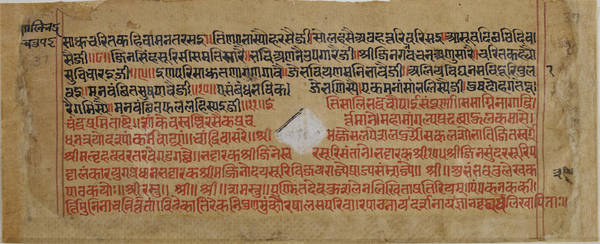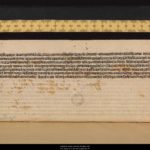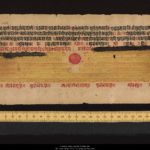Article: Jain calendar
Different types of calendars have always co-existed in India and this is still the case because each calendar is used in different parts of life. The ancient religious calendars of the many faiths found in India are widely used in the present day, particularly when calculating the dates of holy days. However, secular dating systems have also been used, mainly based on dynastic or regnal periods. Nowadays, the official national calendar of India is a civil calendar, based on the Śaka era system. Each of the 12 months in the year has 30 or 31 days and the new year begins with the month of Caitra, which starts in late March of the Western calendar. However, the Western or Gregorian calendar is also commonly used.
In Indian-language writings the dates are given in the era, year, month and day. These vary depending on the system used. Frequently, two or more dating systems are used in a single manuscript or publication.
The era may be chosen from a number of systems. The month is a lunar month, which is different from a solar month. The Gregorian or Western calendar is a solar calendar, based on the sun, whereas Indian calendars are based on the phases of the moon. A lunar month has two halves and dates are frequently described as belonging to the ‘bright half’ or the ‘dark half’ of the month. The lunar calendar has some significant differences from the solar calendar and it also varies slightly in the diverse regions of India.
The dates of Jain festivals are calculated using the traditional lunar calendar. The Jain religious calendar has its own characteristics. The year falls into two distinct parts – the rainy season and the rest of the year. The religious significance of the rainy season is underlined by the amount of discussion in Jain sacred writings devoted to this four-month period.
The complex nature of dates in Indian texts may occasionally lead to different interpretations of when an historical event happened or when a festival should take place. The intricate systems of dating are also a vital consideration when working out the equivalent date in the Western calendar.
Eras and years
In India, mention of a year alone is not enough to create a date. The year has to be located within an era. All through their history up to the present day, the Jains have employed the systems of eras used generally in India but they have also created their own system of eras.
Indian eras used by the Jains
The two systems of eras frequently found in Jain writings were both used in wider Indian society. The Vikrama era dating system is still very widespread today while the Śaka era system is now obsolete, though it forms the basis of the Indian national civil calendar.
Vikrama era
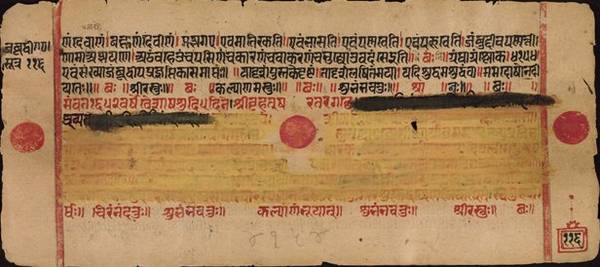
Partly erased colophon
Image by Bodleian Libraries, University of Oxford © Bodleian Libraries, University of Oxford
The Vikrama era that began in 58 BCE, or Vikrama-saṃvat is predominantly used in western and northern India. It is frequently abbreviated to vi. saṃ. or VS in transliteration.
It is very common in the dating of Jain manuscripts and inscriptions from earlier times. Examples can be seen in this manuscript at the British Library and in this manuscript colophon and the end of a manuscript, both at the Bodleian Library. Even today Jain books written in various Indian languages and published in India often use this dating system, sometimes alone, sometimes alongside another era.
Generally, the year is counted when it has finished. Therefore in order to get the equivalent year in the Common Era, one has to subtract 57 or 56. For example vi. saṃ. 1754 = 1697 CE.
The term ‘Vikrama’ refers to a king named Vikramāditya. Though not the founder of this era, he became associated with it, as recent historical discoveries have shown (Salomon 1998: 182).
Śaka era
Beginning in 78 CE, the Śaka era or Śaka-saṃvat was once widespread in western India, particularly in Gujarat and Saurashtra. It is used extensively in Jain manuscripts and inscriptions. Sometimes it is mentioned alone, but, in most cases, it occurs together with the date in the Vikrama era. It is no longer in use today.
Generally, the year is counted when it has finished. Therefore in order to get the equivalent year in the Common Era, one has to add 78 to the Śaka era date. This example shows the date as part of the colophon, written in red ink.
The term ‘Śaka’ refers to a king, most probably belonging to ‘one of the non indigenous dynasties of the first century A.D.’ (Salomon 1998: 184).
Ilāhī era
The Ilāhī era – Tārīkh-i-Ilāhi in Arabic – was instituted by the Mughal emperor Akbar in 1556 CE. It is found in Jain inscriptions and historical records or chronicles of Akbar’s time but was employed neither systematically nor alone. Instead, it was used rather consciously by Śvetāmbara authors – monks or lay people – or scribes who had close connections with the court and wanted to show their respect and allegiance to the emperor.
Christian or Common Era
The Christian era – known as Isvī san, san or khrīstābda – is occasionally used in modern Jain books written in the Indian languages and published in India today. However, it is normally used in tandem with the dating systems more commonly found in India.
Jain eras
The Jain era, known as Vīra-saṃvat and abbreviated as vī° saṃ°, starts from 527 BCE in the Śvetāmbara tradition or 662 BCE according to the Digambaras. This is the year of the emancipation from the cycle of rebirth of Mahāvīra, the 24th Jina.
Although this dating system is of great importance in the written tradition, it has not been used as often as might be expected. For example, it is not found in manuscript colophons and only occasionally in inscriptions. However, it is known from Jain texts, and Jain authors use it when referring to the date of a work. Even so, from the 20th century it has been widely used in books which Jains have published in India.
This dating system is habitually used along with others in published works. There are plenty of examples of cumulative dating formulas, such as vīrābda 2480 vaikramābda 2010 śākābda 1876 khristābda 1954 for 1954 CE.
The 2500th year of the Jain era, which corresponds to 1973 to 1974 CE, is specially well known because it saw great celebrations of Mahāvīra’s teachings. The day Mahāvīra attained nirvāṇa is also the date of the Jain Dīvālī.
Some Jain books written in the Indian languages and published in India since the 20th century show a new development. This is the creation of new eras connected with the names of Śvetāmbara religious teachers regarded as leading figures by their group of followers. These eras start in the year the religious teachers’ died. For example, dharma saṃ. 25 refers to Vijayadharma-sūri, who died in 1921, and equates to 1946 CE. These eras are used only within very limited circles, however, since these eponymous teachers do not enjoy the same status among all Śvetāmbara Jains.
The Jain year
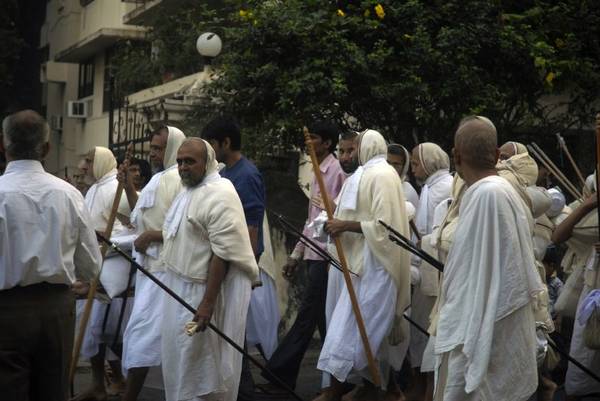
Śvetāmbara monks
Image by Hoorob – Robert Tyabji © CC BY-NC-ND 3.0
The 12 months of the Jain year begin the day after the festival of Dīvālī, which takes place in late September to October in the Western calendar. The exact date varies because it is calculated using the lunar calendar.
From the point of view of Jain religious life and practice, the fundamental division of the year is between the rainy season and the rest of the year. This distinction has been in effect since the beginnings of Jainism and has its own terminology. The four-month period is commonly known as cāturmāsa in Sanskrit, comāsa in Hindi and comāsu in Gujarati. It starts on Āṣāḍha Bright 14 – corresponding to mid-July -– and ends with Kārttika Bright 15 in regions affected by the north Indian climate. The rest of the year is referred to as ‘eight months’ or by an old technical term long since out of use, the Prakrit uubaddha or Jain Sanskrit ṛtubaddha (see Balbir 1997).
This distinction determines major differences and specific rules in the behaviour of monks and nuns. Outside the monsoon season, Jain mendicants have a wandering life, in which they do not stay anywhere longer than a few days. During the monsoon they are supposed to stay in one place, creating a period of close interaction between mendicants and laity. Thus this is a time for intense religious practice for lay people and for important festivals such as Paryuṣaṇ. The arrival of a monastic group for the four-month period is welcomed with great pomp by the local laity and has led to the creation of a special type of artefact among Śvetāmbaras, the ‘letters of invitation’ – vijñapti-patras. The British Library holds a colourful example from the 18th century.
The rainy season is a time when life becomes more abundant, because of the combined effect of warmth and humidity. This is especially true of minute forms of life. This period is therefore also a time when it becomes very easy to harm living creatures by accident, thus breaking the Jain tenet of non-violence without meaning to. Moreover, travel becomes more difficult for practical reasons, especially for Jain ascetics, who can only travel on foot. Therefore they stay in a single place for the duration of the rainy season. In addition, pilgrimages are not performed, so in normally vibrant sacred places, such as Mount Shatrunjaya, the managing trusts do not make the usual facilities available.
Lunar calendar
From the past up to the present day, several calendars have been used side by side in India, depending on the purpose involved. For daily life, the solar month and the civil day are relevant. In the modern Indian languages from north India, such as Hindi and Gujarati, the English names of the 12 months are in common use today. But in matters of religious practice, the only relevant calendar is the lunar calendar.
The basic components of the lunar calendar are the lunar month, the lunar fortnight and the lunar day. Thus, for Jains, as among Hindus, the dates of religious festivals or any other religious occasions are expressed as follows: ‘third day of the bright fortnight of the month X’ or ‘X Bright / Dark 1 (to 15)’.
Following custom, lunar calendars listing all the Jain festivals of the year are published as booklets or are now available on the web. They are the so-called Jain pancāngs. In their tables they also give the equivalent dates in the modern Western system, which contemporary Jains increasingly use in daily life.
Lunar month
There are 12 lunar months in a year of the lunar calendar. A lunar month is the interval between two new moons or two full moons and lasts around 28 days. A Western month is based on the solar calendar so each Indian month begins about halfway through a Western month. The names of Indian months are derived from the names of the constellation – nakṣatra – where the corresponding full moon is at that time. For instance, in Caitra the full moon is in the constellation Citrā, in Vaiśākha the full moon is in the constellation Viśākha and so on.
|
Sanskrit names |
Gujarati names |
English equivalent |
|---|---|---|
|
Caitra |
Caitra |
March to April |
|
Vaiśākha |
Vaiśākh |
April to May |
|
Jyeṣṭha |
Jeṭh |
May to June |
|
Āṣāḍha |
Āṣāḍh |
June to July |
|
Śrāvaṇa |
Śrāvan |
July to August |
|
Bhādrapada |
Bhādarvā |
August to September |
|
Āśvina |
Āso |
September to October |
|
Kārttika |
Kārtak |
October to November |
|
Mārgaśīrṣa |
Māgsar |
November to December |
|
Pauṣa |
Poṣ |
December to January |
|
Māgha |
Māgh |
January to February |
|
Phālguna |
Fāgan |
February to March |
The Gujarati names of the months are in widespread use in contemporary India and are clearly corruptions of the original Sanskrit terms.
In India the start of the year differs according to three factors. The first one is the era used, the second is the region of India and the last is the sphere of activity, which more or less means daily life versus religious life.
|
Era |
Region |
First month of the year |
|---|---|---|
|
Vikrama |
north India |
Caitra |
|
Vikrama |
south India |
Kārttika |
|
Śaka |
everywhere |
Caitra |
|
Jain era and Jain religious year |
everywhere |
Kārttika with Dīvālī |
|
everywhere |
Kārttika with Dīvālī |
Lunar fortnight
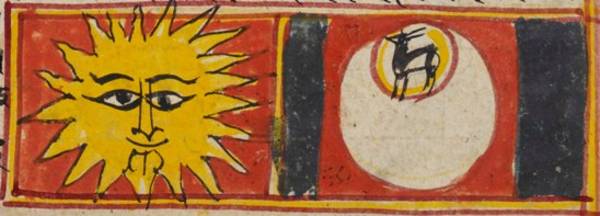
Sun and moon
Image by British Library © CC0 1.0 (Creative Commons Public Domain)
Each lunar month is divided into two fortnights – pakṣa in Sanskrit – the ‘dark’ fortnight and the ‘bright’ fortnight.
The dark fortnight or ‘dark half‘ runs from the full moon to the new moon. It is known by an assortment of names, such as kṛṣṇa-pakṣa, asita-pakṣa or any other adjective meaning ‘black’ or ‘dark’ followed by the word pakṣa. In the abbreviated form often used in manuscript colophons, calendars and so on, it is given as vadi or vada.
The bright fortnight or ‘bright half‘ runs from the new moon to the full moon. It is known as śukla-pakṣa or any other adjective meaning ‘white’ or ‘bright’ plus pakṣa. In the abbreviated form often used in manuscript colophons, calendars and so on, it is usually sudi or suda.
The beginning of the month depends on the region. In the north Indian calendar a month starts with the dark half of the month and ends with the bright half. But Gujaratis follow the south India system, where the month starts with the bright half and ends with the new moon or dark half (see Cort 2001: 179 and 180 with a table).
In the religious calendar, the time of a change in the phase of the moon is crucial and often corresponds to a specific ritual or holy day.
Lunar day
In daily life the basic date unit is the civil day, that is, a day running from sunrise to the next sunrise, also called a solar day.
A lunar day – tithi – is 1/30th of a lunar month and is calculated by the time it takes for the moon to increase its longitudinal angle from the sun by 12 degrees. A lunar day varies from around 19 to 26 hours in length, in contrast to the solar day of 24 hours. Therefore lunar days begin at different times in the solar day, and so the solar and lunar days rarely coincide.
In matters of religious life and the religious calendar, the tithi is the only relevant unit. In dating found in manuscripts or inscriptions, the words used to refer to the day are tithi but also dina and divasa. Occasionally the Arabic loan-word tārīkha, which is common in modern Indo-Aryan languages, is found in late Gujarati works or manuscripts. The Sanskrit term karmavāṭī can also be found in inscriptions and manuscript colophons, such as this example in the British Library. However, it is a rare term recorded in the 12th-century Abhidhānacintāṃaṇi, a thesaurus by the Jain monk and great author Hemacandra. It seems to be a remnant of a specific terminology the Jains devised to refer to ‘civil’ notions of time. Other surviving terms are karma-saṃvatsara for ‘civil year’ and karma-māsa for ‘civil month’ (see Balbir 2011).
Names of the weekdays
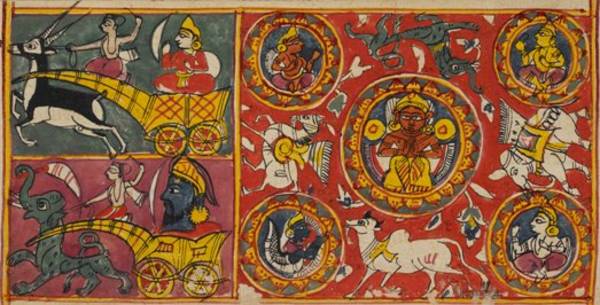
The nine celestial elements
Image by British Library © CC0 1.0 (Creative Commons Public Domain)
Civil days are grouped into sets of seven, which each forms a week. The names of the days follow the pattern of a name of a planet plus the word ‘day’ – vāra.
These names appear in the dating of manuscripts, inscriptions and so on and are still in common use today. Note that in the written tradition there is a great variety of possible names, because there are several words used for ‘moon’, ‘Mars’, ‘Jupiter’ and so on.
|
English |
Sanskrit |
Eponymous planet |
|---|---|---|
|
Sunday |
Ravi-vāra, Āditya-vāra |
Sun |
|
Monday |
Soma-vāra |
Moon |
|
Tuesday |
Mangala-vāra |
Mars |
|
Wednesday |
Budha-vāra |
Mercury |
|
Thursday |
Guru-vāra, Bṛhaspati-vāra |
Jupiter |
|
Friday |
Śukra-vāra, Bhṛgu-vāra |
Venus |
|
Saturday |
Śani-vāra |
Saturn |
Western and Indian dates
The complexity and variety of dating systems that have been used in Indian societies mean that several items have to be taken into account when calculating the exact Western equivalent of Indian dates. When looking at dates given in Indian-language writings, the era has to be identified, the exact lunar calendar confirmed and the day calculated.
Complications in calculations partly explain occasional Jain disputes over dates of festivals. Disagreements regarding the important festival of Paryuṣaṇ, for example, were quite intense in the 20th century (see Cort 1999 for more about disputes between the Śvetāmbara monastic orders in 1986).
Reading
- ‘A New Instance of Common Jaina and Buddhist Terminology’
Nalini Balbir - Facets of Indian Culture: Gustav Roth felicitation volume, published on the occasion of his 82nd birthday
edited by C. P. Sinha, Kameshwar Prasad, Jagdishwar Pandey, Umesh Chandra Dwivedi and Rajendra Prasad
Bihar Puravid Parishad; Patna, Bihar, India; 1998
- ‘Calendar terminology: A note on Hemacandra’s Abhidhānacintāmaṇi and Sanskrit karmavāṭī’
Nalini Balbir - Anusandhān
volume 54
2011
- ‘Fistfights in the Monastery: Calendars, Conflict and Karma among the Jains’
John E. Cort - Approaches to Jaina Studies: Philosophy, Logic, Ritual and Symbols
edited by N. K. Wagle and Olle Qvarnström
Centre for South Asian Studies, University of Toronto; Toronto, Canada; 1999
- Jains in the World: Religious Values and Ideology in India
John E. Cort - Oxford University Press USA; New York, USA; 2001
- Indian Epigraphy: A Guide to the Study of Inscriptions in Sanskrit, Prakrit, and the Other Indo-Aryan Languages
Richard Salomon - South Asia Research series; volume 2
Oxford University Press USA; New York, USA and Oxford, UK; 1998
- +
- aAbhavya
- aAbhinandana
- aAbhiṣeka
- aĀcāra
- aĀcārāṅga-sūtra
- aĀcārya
- aAchalbhrata
- aAḍhāī-dvīpa
- aAdharma
- aAdho-loka
- aAdhyayana
- aAdvaita Vedānta
- aĀgama
- aAghātīya
- aAghātīya-karman
- aAgnibhuti
- aAgra
- aĀhāra
- aAhiṃsā
- aAhimsa Day
- aAjita
- aAjīva
- aAkampit
- aĀkāśa
- aAkbar the Great
- aAkṣaya-tṛtīyā
- aAlauddin Khalji
- aAlbert Einstein
- aAllah
- aAlms
- aĀlocanā
- aAloka-ākāśa
- aAmāri
- aAmbikā or Kūṣmāṇḍinī
- aAnagāra
- aAnanta
- aAnarthadaṇḍa
- aAnaśana
- aAnekānta-vāda
- aAṅga
- aAniconism
- aAnojjā
- aAntarāla
- aAntarāya-karma
- aAṇu
- aAṇu-vrata
- aAnukampā
- aAnuprekṣā
- aAnusvāra
- aApabhraṃśa
- aAparigraha
- aAra
- aĀrambha
- aĀrambhaja
- aĀratī
- aArdhamāgadhī Prākrit
- aArhaṃ
- aArhat
- aArśana-āvaraṇīya-karma
- aĀrta-dhyāna
- aĀryikā
- aĀryikā Jñānamati
- aĀśātanā
- aĀścarya
- aAscetic
- aAsceticism
- aAshram
- aAspiration
- aĀsrava
- aAṣṭa-maṅgala
- aAṣṭāpada
- aAstikāya
- aAstrolabe
- aAsura
- aAtheism
- aAticāra
- aAtiśayakṣetra
- aAtithisaṃvibhāgavrata
- aĀtma-vāda
- aĀtman
- aAuṃ
- aAurangzeb
- aAuspicious
- aAusterity
- aAvadhāna
- aAvadhi-jñāna
- aĀvaraṇī-yakarman
- aAvasarpiṇī
- aAvatāra
- aAvidyā
- aAxiom
- aĀyāga-paṭa
- aĀyambil
- aĀyu-karma
- aĀyurveda
- bBabur
- bBāhubali
- bBaladeva
- bBālāvabodha
- bBandha
- bBasadi
- bBazaar
- bBhadrankarvijay
- bBhagavant
- bBhaktāmara-stotra
- bBhakti
- bBhale
- bBharata
- bBhāṣā
- bBhāṣya
- bBhaṭṭāraka
- bBhāva
- bBhāva-pūjā
- bBhāvanā
- bBhavana-vāsin
- bBhavya
- bBhavyatva
- bBhaya
- bBhoga-bhūmi
- bBhogopabhoga
- bBodhi
- bBollywood
- bBrahmā
- bBrahma-deva
- bBrahmacārī
- bBrāhmaṇa
- bBraj Bhāṣā
- bBright fortnight
- bBritish Raj
- bBuddha
- bBuddhi-sagar
- bBuddhism
- bBuddhist
- cCaitya
- cCaityavāsin
- cCakravartin
- cCakreśvarī
- cCāmara
- cCandanā
- cCandragupta
- cCandraprabha
- cCanon
- cCāritra
- cCāritramohanīya-karman
- cCarũrī
- cCaste
- cCaturvidha-saṅgha
- cCaturviṃśati-stava
- cCāturyāma
- cCE
- cCelibacy
- cCha
- cChadmastha
- cChastity
- cCheda-sūtra
- cChristian
- cChristianity
- cClergy
- cCloning
- cColophon
- cCommentary
- cConch
- cConfession
- cCongregation
- cConsecration
- cCosmology
- cCremation
- cCrore
- cCult
- cCūrṇi
- dDādā-guru
- dDalit
- dDāna
- dDaṇḍa
- dDark fortnight
- dDarśana
- dDarśanamohanī-yakarman
- dDaśa-lakṣaṇa-parvan
- dDeity
- dDelhi Sultanate
- dDerāsar
- dDeśāvakāśika-vrata
- dDetachment
- dDevanāgarī
- dDevānandā
- dDevarddhi-gani
- dDevotee
- dDhamal
- dDhanuṣ
- dDhāra
- dDharma
- dDharma-dhyāna
- dDharma-sāgara
- dDharmastikaya
- dDhātakīkhaṇḍa
- dDholak
- dDhyāna
- dDiaspora
- dDig-vrata
- dDigambara
- dDīkṣā
- dDisciple
- dDīvālī
- dDivya-dhvani
- dDNA
- dDoctrine
- dDogma
- dDonor
- dDoṣa
- dDravya
- dDravya-pūjā
- dDrone
- dDuṣamā
- dDuṣamā-duṣamā
- dDuṣamā-suṣamā
- dDveṣa
- dDvīpa
- eEast India Company
- eEightfold Path
- eEkānta-vāda
- eEkendriya
- eElder
- eElders
- eEschatology
- eEtc up to
- fFarmān
- fFast
- fFatehpur Sikri
- fFestival
- fFestschrift
- fFiruz Shah
- fFly-Whisks
- fFolio
- fFour Noble Truths
- gGaccha
- gGaṇa
- gGaṇadhara
- gGanadharavada
- gGaṇeśa
- gGaṇin
- gGarba
- gGarbha
- gGarbha-gṛha
- gGaruḍa
- gGati
- gGene
- gGenomics
- gGhātī-yakarman
- gGhātīya
- gGhaznavid
- gGhiyasuddin Tughlaq
- gGhurid
- gGloss
- gGotra-karma
- gGujarāt
- gGujarati
- gGuṇa
- gGuṇa-sthāna
- gGuṇa-vrata
- gGupti
- gGuru
- gGuruṇī
- hHagiography
- hHajj
- hHaṃsa
- hHaribhadra
- hHariṇaigameṣin
- hHasta
- hHeresy
- hHiṃsā
- hHindi
- hHindu
- hHinduism
- hHīravijaya
- hHoroscope
- hHrīṃ
- hHumayun
- hHymn
- iIconoclasm
- iIconography
- iIdol
- iIndian Independence
- iIndology
- iIndra
- iIndrabhūti Gautama
- iIndriya
- iInitiation
- iIntercession
- iInvocation
- iIQ
- iIslam
- iIslamicate
- iIṣṭadevatā
- iĪśvara
- jJagat
- jJahangir
- jJain
- jJaina Devanāgarī
- jJaina Śaurasenī
- jJaina-dharma
- jJainaśāsana
- jJainness
- jJaisalmer
- jJamāli
- jJambū-dvīpa
- jJames Burgess
- jJanma
- jJanma-kalyāṇa
- jJarā
- jJāti
- jJina
- jJina-āgama
- jJina-bhavana
- jJina-bimba
- jJina-mātā
- jJinacandra-sūri
- jJinadatta
- jJinaprabha
- jJīva
- jJñāna
- jJñāna-āvaraṇīya-karma
- jJñāna-āvarṇiya
- jJñānsundar
- jJyotiṣka
- kKāla
- kKālakācārya-kathā
- kKālidāsa
- kKalpa-sūtra
- kKalpa-vṛkṣa
- kKalyāṇaka
- kKalyanvijay
- kKamaṇḍalu
- kKamaṭha
- kKarma
- kKarma-bhūmi
- kKarma-grantha
- kKarma-prakṛti
- kKarma-vāda
- kKarmon
- kKarnataka
- kKaṣāya
- kKathā
- kKāvya
- kKāya
- kKāyotsarga
- kKeśa-loca
- kKetu
- kKevala-jñāna
- kKevalin
- kKhalji
- kKharatara-gaccha
- kKnowledge
- kKriyā
- kKriyā-vāda
- kKṛṣṇa
- kKṣamā-śramaṇa
- kKṣapakaśreṇi
- kKṣatriya
- kKṣullaka
- kKulakara
- kKundakunda
- kKunthu
- lLabdhi
- lLaity
- lLakh
- lLāñchana
- lLands of Action
- lLaukāntika
- lLavaṇa-samudra
- lLeśyā
- lLiṅga
- lLinguistics
- lLoka
- lLoka-ākāśa
- lLoka-puruṣa
- lLoka-vāda
- lLotus
- lLotus lake
- mMadhya-loka
- mMahā-videha
- mMahā-vrata
- mMahābhārata
- mMahāmastakābhiṣeka
- mMāhārāṣṭra
- mMāhārāṣṭrī Prākrit
- mMahattarā Yākinī
- mMahāvīr Jayantī
- mMahāvīra
- mMakāra
- mMakkhali Gośāla
- mMalli
- mMāna-stambha
- mManaḥ-paryāya-jñāna
- mMaṇḍala
- mMaṇḍapa
- mMandit
- mMaṅgala
- mMantra
- mMantras
- mManuṣya-loka
- mMarāṭhī
- mMārgaṇā
- mMartyr
- mMarudevī
- mMaṭha
- mMati-jñāna
- mMauryaputra
- mMecca
- mMendicant lineage
- mMetarya
- mMiracle
- mMithyādṛṣṭi
- mMohandas Gandhi
- mMohanīya-karma
- mMokṣa
- mMonastic order
- mMonasticism
- mMonk
- mMonotheism
- mMosque
- mMount Meru
- mMount Sammeta
- mMṛgāvatī
- mMughal
- mMuhammad
- mMuhammad bin Tughlaq
- mMuhpattī
- mMūla-sūtra
- mMūlaguṇa
- mMumbaī
- mMuni
- mMunisuvrata
- mMurad Bakhsh
- mMūrti-pūjaka
- mMuslim
- mMysticism
- nNābhi
- nNāga-kal
- nNāgapurīya Tapā-gaccha
- nNāgarī
- nNāma-karma
- nNamaskāra-mantra
- nNami
- nNandīśvara-dvīpa
- nNandivardhana
- nNandyāvarta
- nNāraka
- nNāraki
- nNasalisation
- nNātha
- nNavrātrī
- nNaya-vāda
- nNemi
- nNidāna
- nniggaṃthāṇa vā 2
- nniggaṃtho vā 2
- nNigoda
- nNihnava
- nNikṣepa
- nNirgrantha
- nNirjarā
- nNirvāṇa
- nNiryukti
- nNiṣidhi
- nNitya
- nNiyati
- nNo-kaṣāya
- nNudity
- nNun
- oOcean of milk
- oOmniscience
- oOrdination
- ppa°
- pPadmaprabha
- pPadmāsana
- pPadmāvatī
- pPādukā
- pPalanquin
- pPalette
- pPañca-muṣṭi
- pPāṇḍava
- pPaṇḍit
- pPandit Dalsukh D. Malvania
- pPandit Sukhlalji
- pPāṇipātra
- pPāpa
- pParamātman
- pParameṣṭhin
- pPāraṇā
- pParigraha
- pPariṇāma
- pParīṣaha
- pParokṣa
- pPārśva
- pPārśvanātha
- pParyāya
- pParyuṣaṇ
- pPaṭa
- pPatan
- pPātra
- pPenance
- pPersian
- pPhala
- pPhilology
- pPicchikā
- pPilgrimage
- pPīr
- pPolymath
- pPoṣadha
- pPossession
- pPothī
- pPrabhas
- pPradakṣiṇā
- pPradeśa
- pPrākāra
- pPrakīrṇaka-sūtra
- pPrākrit
- pPramāda
- pPramukhā
- pPrati-vāsudeva
- pPratikramaṇa
- pPratimā
- pPratiṣṭhā
- pPratyākhyāna
- pPratyakṣa
- pPravacana
- pPrāyaścitta
- pPrayer
- pPre-modern
- pPreach
- pPredestination
- pProtestant
- pProvenance
- pPudgala
- pPūjā
- pPujārī
- pPukharavara-dvīpa
- pPuṇya
- pPūrva
- pPuṣkara-dvīpa
- pPuṣpadanta
- pPyre
- qQur’an
- rRāga
- rRāhu
- rRainy season
- rRajasthan
- rRajasthani
- rRājimatī
- rRajoharaṇa
- rRajput
- rRāma
- rRāmāyaṇa
- rRangoli
- rRās-garbā
- rRasa
- rRathanemi
- rRatna-traya
- rRātri-bhojana
- rRaudra-dhyāna
- rRecto
- rRelic
- rRenunciation
- rRetroflex
- rRevatī
- %Ṛg-veda
- rRite
- rRosary
- %Ṛṣabha
- %Ṛṣabhanātha
- rRupee
- sSaciyā Mātā
- sSādhu
- sSādhvī
- sSāgāra
- sSaint
- sŚaivaism
- sŚaka-saṃvat
- sSallekhanā
- sŚalya
- sSamacatuṣṭha
- sSamādhimaraṇa
- sSamaṇi
- sSāmarambha
- sSamavasaraṇa
- sSāmāyika
- sSaṃbhava
- sSamiti
- sSaṃjñā
- sSaṃkalpaja
- sSaṃsāra
- sSamudghāta
- sSaṃvara
- sSaṃvega
- sSamyak-cāritra
- sSamyak-darśana
- sSamyak-jñāna
- sSamyaktva
- sSaṃyama
- sSanctuary
- sSandalwood
- sSaṇgha
- sSanskrit
- sSant
- sŚānti
- sSapta-bhaṅgi-naya
- sSārambha
- sSarasvatī
- sSarvajña
- sSāsan-devi
- sŚāsana-devatā
- sŚāstra
- %Ṣaṭ-jīvanikāya
- sSatī
- sSatīmātā
- sSatya
- sSchism
- sScribe
- sScripture
- sSect
- sSecularism
- sŚenāī
- sSermon
- sŚeṣavatī
- sSevā
- sSeven fields of donation
- sShah Jahan
- sShantidas Jhaveri
- sShrine
- sSiddha
- sSiddha-śilā
- sSiddhacakra or Navadevatā
- sSiddhānta
- sSiddhārtha
- sSiddhi
- sSikh
- sSikhism
- sŚikṣā-vrata
- sŚīla
- sSin
- sSindh
- sŚītala
- sŚiva
- sSkandha
- sSomanatha
- sŚraddhā
- sŚramaṇa
- sŚrāvaka
- sŚrāvakācāra
- sŚrāvikā
- sŚreyāṃsa
- sŚrī
- sŚrīvatsa
- sŚruta-jñāna
- sŚruta-pañcamī
- sSthānaka-vāsin
- sSthāpanācārya
- sSthāvara
- sSthavira
- sSthiti
- sStrīmukti
- sStūpa
- sSubcontinent
- sSudarshana
- sŚuddhi
- sSudharma
- sŚūdra
- sSufism
- sSukha
- sŚukla-dhyāna
- sSulasā
- sSultan
- sSumati
- sSundarśrī
- sSupārśva
- sSūri
- sSuṣamā
- sSuṣamā-duṣamā
- sSuṣamā-suṣamā
- sSūtra
- sSuyam me ausam! Tenam bhagavaya evamakkhayam
- sSvādhyāya
- sSvāhā
- sSvastika
- sŚvetāmbara
- sŚvetāmbara Terāpanthin
- sŚvetāmbaras
- sSwan
- sSyād-vāda
- tTabla
- tTantra
- tTapā-gaccha
- tTapas
- tTāraṇ Svāmī Panth
- tTattva
- tTattvārtha-sūtra
- tTemple
- tTemple-city
- tThe Enlightenment
- tTheology
- tThree worlds
- %Ṭīkā
- tTilaka
- tTīrtha
- tTīrthaṃkaranāma-karman
- tTīrthankara
- tTransliteration
- tTrasa
- tTrasa-nāḍī
- tTriśalā
- tTriṣaṣṭi-śalākā-puruṣa-caritra
- tTti bemi
- tTughlaq
- tTunk
- uUdumbara
- uUniversal History
- uUpādhyāya
- uUpāṅga
- uUpaniṣads
- uUpāsaka
- uUpasarga
- uUpāśraya
- uŪrdhva-loka
- uUtsarpiṇī
- uUttarādhyayana-sūtra
- vVāhana
- vVaimānika
- vVairāgya
- vVaiṣṇava
- vVaiśramaṇa
- vVaiśya
- vValabhī
- vVanaspatikāya
- vVandana
- vVaṇik
- vVarṇa
- vVāsudeva
- vVāsupūjya
- vVayubhūti
- vVeda
- vVedanīya-karma
- vVegetarianism
- vVehicle
- vVernacular
- vVerso
- vVidyā
- vVidyā-devī
- vVihāra
- vVijñapti-patra
- vVikrama-saṃvat
- vVikṛti
- vVimala
- vVinaya
- vVipāka
- vVirji Vora
- vVirodhaja
- vVīrya
- vVisarga
- vViṣṇu
- vVītarāga
- vVizier
- vVotive
- vVow
- vVrata
- vVS
- vVyakta
- vVyantara
- vVyasana
- yYakṣa
- yYakṣī
- yYantra
- yYaśoda
- yYaśovijaya
- yYati
- yYātrā
- yYoga
- yYoginī
- yYojana


